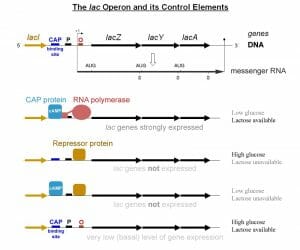Lac Operon Definition
The lac operon, short for lactose operon, is a series of three genes in bacteria that produce the necessary enzymes to obtain energy from lactose. An operon is any series of genes that are controlled by the same promoter and operator sequences, which tell the enzymes responsible for transcribing mRNA where to attach to the DNA. Typically, glucose is the sugar of choice for bacterial organisms, but when this supply runs lows, the lac operon allows the organisms to survive on lactose. The three genes contained within the lac operon are lacZ, lacY, and lacA. Each gene produces a specific enzyme needed to process lactose, but it also takes energy to produce these enzymes.
LacY produces an enzyme responsible for transporting lactose through the cell membrane, allowing the bacteria to access the resource. LacZ is the enzyme required to separate lactose into its constituent parts, galactose and glucose. The final gene, lacA, produces a molecule which may help metabolize galactose. Two regulatory mechanisms ensure that the genes of the lac operon are not expressed when they aren’t needed. First, when lactose is not available to the organism, the organism cannot express the lac operon. This condition is caused by another gene, lacl, which exists near the lac operon in the genome. See the image below:
While lacl gene is expressed all the time, it produces a protein which blocks the promoter region of the lac operon. This protein will bind to the operator region of the lac operon until molecules of lactose bind to it. When lactose is present in high enough concentrations, all of the lacl protein becomes bound up, and the lac operon can be expressed. The second regulatory mechanism of the lac operon involves the presence of glucose. In the presence of glucose, the concentration of a signal molecule cAMP remains low. When glucose is absent, cAMP is high and binds to specific protiens that promote the attachment of RNA creating proteins to the DNA, which increases the expression of the lac operon. Several other smaller regulatory mechanisms inhibit the transportation of lactose when glucose is present, so the cell will utilize the more energy efficient material first. The following diagram shows the different expression sequences of the lac operon.
Bacterial use these complex mechanisms of regulation to only express the lactose digesting proteins in the right environment. Many other operons exist that are similar in form, and control the metabolism of other substances. The importance of the operon lies in that all the genes are expressed at the same time, allowing a cell to immediately be able to active an entire metabolic pathway with only a few chemical signals.
Related Biology Terms
- Operon – Several genes that are transcribed at the same time, due to sharing a promoter region.
- Gene – A functional unit of DNA that produces a protein.
- RNA Polymerase – The enzyme responsible for assembling messenger RNA by matching nucleotides to the DNA sequence.
Quiz
1. A colony of bacteria live within the gut of a predator. The predator catches a small mammal, which has both glucose stored in the blood and cells, as well as lactose produced by the mammary glands. When the predator eats the small mammal, the bacteria in the predator’s gut have a chance to digest all of the materials. Is the lac operon expressed?
A. Yes
B. No
C. Only at a basal level
2. A scientist finds a molecule which acts in the same way as cAMP, binding to the DNA and allowing a greater transcription of the lac operon to occur in bacteria. The scientist feeds these bacteria lactose and glucose, and expects that they will grow much faster than bacteria that cannot process both glucose and lactose at the same time. Is he right?
A. Yes, they will obtain much more energy than typical bacteria
B. No, the lac operon will not function in these conditions
C. No, cells are limited by other factors

